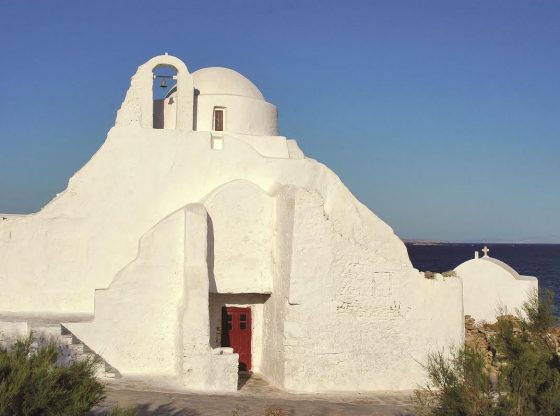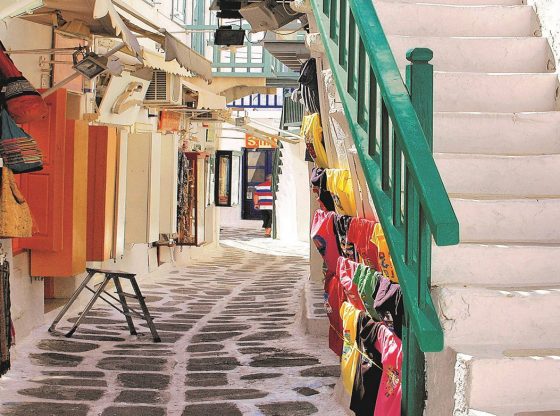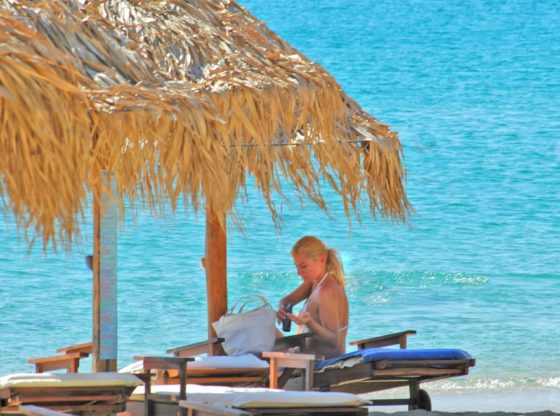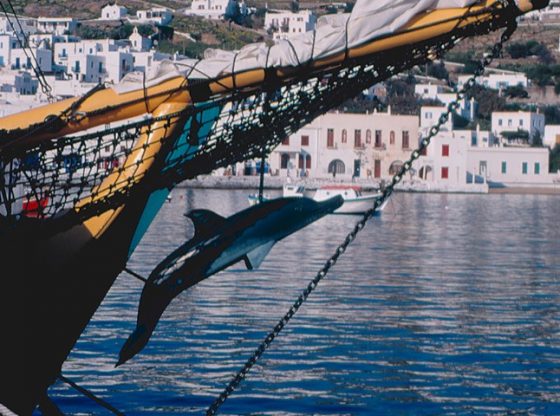Mykonos Travel Guide
The Mykonos Mini-Guide for 2, 3, 4, 5 days
So, you’re coming to Mykonos! Super!
It may be a small island—just 12 kilometers across—but there is a lot to do here, so you need to budget your time well so you can enjoy unique experiences that “the Rock” of the Aegean has to offer. www.mykonos Greece.com has mapped out a listing of “must dos in Mykonos” based on how much time you have on the island. How you spend your time in Mykonos will depend largely on how much time you have; ideally, the more time the better and not high season.
How will you get around; on foot, public transport or a vehicle? Mobility by vehicle will be a variable as many of the recommended places to go and sites to see are not connected by public transportation. In town-Chora- you will have to walk everywhere as motorized vehicles are not permitted within the city limits. Out of town will require that you hire: a motor scooter, quad, car, private livery service or taxi. Follow the links here for getting around the island.
If you come to Mykonos, these are the places you must visit, the things you must do to say that YOU HAVE BEEN THERE: Petros the Pelican, Church of Paraportianni, Little Venice, The Windmills, Lighthouse, Ano Mera /Monastery/Town Square, Sunset, The Lighthouse, the nude beaches, the rockin music clubs and bars www.mykonosgreece.com recommends the itinerary below, according to your length of stay, so that you can fit it all in,based on your time on the island.
2 to 5 days in Mykonos
2 days
Day 1 morning Day
Café on the “Yialos” Lighthouse,Petros the Pelican, Ano Mera /Monastery/,Town Square,Church of Paraportianni
After 1 pm
Little Venice,The Windmills,Beach and lunch
After 6 pm
Chapels Archaeological Museum,Shopping Sunset from a café on the yialos
Dinner, Drinks, Ksefantoma!
2 Morning
Town Square,café on the yialos, shoping
After 1 pm
Beach and lunch,Drinks…
After 6 pm
Maritime Museum,Lena’s House Museum,Sunset/Windmills and Little Venice
After sunset
Mykonos Folk Museum,Dinner,Drinks,Ksefantoma!
Day 3 – morning
Delos Cross country safari
After 3 pm
Beach and lunch
After sunset
Dinner, Drinks,Ksefantoma!
Day 4 Morning
Little Venice,The Windmills,café on the yialos
After 1 pm
Beach and lunch,Drinks…
After 7 pm
Shoping,air cinema,Dinner…
Day 5 Morning
Sail tour of the island/Kayaking tour of the island
If you have more than two days and depending on the weather—because some days the wind is extreme and the boats do not sail, you can interchange your activities. Beach choice will literally depend on which way the wind is blowing. Below are brief descriptions of the listed activities, monuments, landmarks.
In town/Chora– Exploring the labyrinth
The Pelican
You will spot him where you least expect, within the narrow walkways of the islands’ labyrinth, with dozens of folks gathered around trying to take selfies or just get a shot of him. In the mornings, he waddles around the waterfront near the fishmonger’s market. Mykonos has its own celebrity—a friendly feathered pelican with a snapping yellow beak that comes before everything else.
Church of Paraportiani
The building probably holds the Guinness for the most photographed church on the planet. It is not actually 1 church but 5 in total. It is located in the “Kastro” area (the initial fortress on the island). Panagia Paraportiani consists of five small churches that were built one on top or next to the other. The church of Agios Efstathios is the centre of this complex, surrounded by the churches of Agios Anargyros, Agios Sozon and Agia Anastasia.
Windmills (Kato Mili, above Little Venice)
What would the island of the winds be without its windmills? And windmills there are plenty, but the largest conglomeration sit on the shore just above little Venice, once catching the full strength of the north wind pushing across the water to turn its sails to grind grain. Today they remain stoic reminders of the past as they seem to stand guard over the island’s main town.
Little Venice (Alefkandra)
The houses, like Venice, are built lined along the water, the town’s southwest coast. Most have balconies or Enclosed Turkish balconies that hang out over the water. Some of the bars along this line of buildings often cater to customers who drive their boats right up to the windows! Primary reds, blues and greens vary the spectrum of painted wood that hangs above the sea. Perfect time to appreciate the structures is early morning. The largest crowds gather at sunset to watch the sea swallow the sun in a blaze of pinks, purples, oranges and blues—sunset varies depending upon the time of year—anywhere between 6:30 to 8:30 pm.
The Waterfront (The Yialo/The Paraleia)
City Hall
The most unusual building you will find on the island is forefront on the harbor. City Hall is the only building on the island with the orange terra cotta roof—all other buildings have flat roofs according to the building ordinances that preserve the island’s architectural heritage. The municipality’s offices are actually spread out over several buildings in town, but the main building, houses the Mayor’s office, hosts city council meetings as well as preserving and protecting birth and death certificates of the island’s inhabitants. The two-story building that dominates Chora, was initially constructed to become the residency of a Russian earl during the Russo-Turkish war (1770-1774) and was afterwards used as the island’s Town Hall maintaining its initial classic architectural form.
3 Pygadia (3 Wells)
Smack in the center of town is the area known as 3 Pygadia. From the middle of the 18 th century these wells provided the main water supply for Mykonos town until 1956 when a water pumping station was established and began connections to buildings in town. The legend goes that if you drank water from one of the 3 wells you would see the person you were meant to marry! You can find the wells situated next to Louis Vitton and Astra Bar.
Cine Manto Mykonos (Meletopoulos’ Garden) A hidden oasis day or night is the city’s outdoor cinema and garden. Cinema Manto Mykonos operates from May through October providing the latest films at night, under the stars as well as offering an all-day café and restaurant from 10 am until 1 am. The entire garden belonged to Ioannis Meletopoulos, the Piraeus born attorney and eventual a former Governor of National Historical Museum of Athens was a huge benefactor to Mykonos. He donated the property of the garden, its kitchen and the Church of Taxiarchy to the municipality. He also provided the residents with water from the natural well within the garden; the old faucets can be seen just outside the entrance. The garden was the gathering point for socialites, politicians and men of letters hosted by the Meletopoulos family during the summers of the 1940s and 50s. Today, it remains a central gathering point for artistic exhibitions, great food, great film and great conversations. www.cinemanto.gr
The Archaeological Museum
The Archaeological Museum, facing the main waterfront of the city, was erected in 1900 to house finds from the excavations in Delos from the “Pit of Purification” and the necropolis of Rhenia. There is a large collection of vessels especially represented of Cycladic ceramics dating from the Geometric period until the 6th cent. B.C. Also on exhibit are wonderful black figure and red figure pottery and diverse finds, including Hellenistic period gravestones and other sculpture. Among the finds from Mykonos, especially impressive is the “Pithos of Mykonos”: a large urn, (allegedly made in a workshop on Tinos the 7th cent. B.C.) It is decorated in relief depicting various scenes from the Trojan War (the central composition shows Achaian warriors with the Trojan Horse).
The Folklore Museum
The Folklore Museum is the located in an old, two-story, captain’s house in the Kastro area of Mykonos just a few meters distant from the church of Paraportiani. There are six main exhibition halls which house collections of antique furniture,
Byzantine icons, Folkloric ceramics, historical commemorative plates, decorative prints and gravures,
Boni’s Windmill and Lena’s House are divisions of the Mykonos Folklore Museum
Boni’s windmill, located on the edge of the town at Apano Mili, is an outdoor museum, which presents the traditional Mykonian agricultural installation used for the production and processing of farm products: the threshing floor, the well, the oven, the wine-press and the dovecote. The museums centerpiece is the Boni Windmill, which is in full working order and may be visited from June to September. Lena’s House is near the Three Wells; it is a charmingly preserved, authentic 19th century Mykonian middle-class home, completely furnished and equipped with antique furniture and house utensils. Open evenings from April to October
The Aegean Maritime Museum
Located near the 3 Wells, next door to Lena’s House, this museum displays scale models of various rowing boats, sailing vessels and steam-powered ships which, in turn, from Prehistoric times until the present, have traversed the Aegean. The museum is a non-profit organization founded in 1983 with the goal to preserve and promote the Greek maritime history and tradition. It exhibits replicas of rowing and sailing ships from the prehistoric times until today. It also hosts a rich collection of maps, ancient coins and sculptures, all under the thematic umbrella of maritime life. There is a rich collection of maps;
Mykonos Public Library—Kambanis Building
The library of Municipality of Mykonos was founded in 1957 with the initiative and donation of Ioannis Alexandros Meletopoulos, a former Governor of National Historical Museum of Athens. The tomes were actually housed in various buildings that belonged to the municipality, until the Kambanis building was renovated. Asidefrom the more than 10,000 books, largely donated form the historical collection of Meletopoulos, the library houses a large collection of photographs and Documents from the 18 th and 19 th century, gravures, etc. It is located in the square beside the church of Agia Kyriaki, on the ground floor of a marvelous 18th century mansion.
The Panyiotis Kousathanas Library
The Kousathanas library has been added to the municipality’s cultural treasury during the last few years. The scholar and published author has turned his family home into a beehive of educational activity. Housing his collection of books and music as well as Mykonian folk artefacts, he has opened the doors to welcome lectures, poetry readings and musical recitals. The author can often be spotted there, in preparation for the next event as well as enjoying the many tomes the library offers. It is located just off of Fabrika Square, the island’s main bus terminal, on theway to the Windmills.
Out of Town
The Hamlet of Ano Mera
Ano Mera is the island’s number 2, just 8 kilometers away. It has a central square that is flanked by traditional tavernas, a kiosk and an imposing monastery.
The Monasteri of Panagia Tourliani
The monastery, originally built by two priests and dedicated to the Virgin Mary in the year 1542, took its current name “Panagia Tourliani” after a carved icon of the Virgin Mother was found in the area of Tourlos in 1767. Once you are through the walled court yard, having passed through ancient doors that could protect a fortress, the church façade, embellished in carved marble to the top of the bell tower, is striking. The intricately carved wooden altar screen is the work of Florentine artists, circa 1775.
The Monastery of Paleokastro
The Monastery of Paleokastro is a women’s nunnery dating back to the 18th century, which was named after the nearby hill. It is a typical sample of the Cycladic monastery architecture, located north of the settlement of Ano Mera. Visitations there are strictly by appointment.
The Lighthouse/Fanari-Armenistis
This beacon of both light and history dates back to the middle 1800s. It is perhaps one of the best kept secrets on the island, however in recent years the municipality has worked diligently to refurbish the ailing structure, that is under the auspices of the Nava, Ministry. Most recently the ministry has approved a plan for the refurbishing of the lighthouse to serve as a museum and an exhibition gallery. In the past few years there have been concerts set at sunset there.
The Abandon Mines/Metallia-Merchia
On the northern most tip of the island are the abandon mines of MYKOBAR.Active between the 1950s and the 1970s, the Mykobar mines are a big part of the history of the island’s undocumented history, however the municipality has taken on a project to commit memories to a tomme. The mines created hundreds of jobs for people who were poor and hungry after the war, but also claimed lives, both inside the mines and with "Miner’s iIlness" later. The American company that was called Mykobar left the area untouched after they had completed mining for barium there. Presently, the Mykonos Shooting Club has set a practice center there. What remains is the commemorative church of Saint Barbara, as well as homes, offices and work areas now falling to ruin.
Mykonos Vioma Vineyard
Mykonos Vioma was established in 1994. Owner and entrepreneur Nikos Asimomytis ditched a banking career in Athens to return to his beloved Mykonos to create Mykonos Vioma. The family estates in Marathi and Koumiri had been this project’s starting point. Vioma expanded by leasing an abandoned, 3,6 hectares vineyard from the monastery of Panaghia Tourliani in Ano Mera. A total area of 4,4 hectares is cultivated. Except for the wine, vinegar, vine leaves, grape’s molasses and table- grapes are produced. Along with the vineyard, 20 bee-hives, which produce pure organic honey are on the farm. Bread is prepared in a traditional wood oven, using organic flours and a variety of seeds. The garden cultivates organic seasonal egetables. Members of the farm’s family are include: dogs, cats, chickens, turkeys, rabbits and a celebrity donkey, Marika. Mykonos Vioma (the farm) can be visited for tours by appointment as well as wine or local product tasting.
http://www.mykonosvioma.gr/
Delos
Delos is the Sacred Island of the Ancient Greece, a 30-minute boat ride from Mykonos. According to mythology, the island was revealed among the waves of the Aegean to Leto, pregnant by Zeus, hunted by his jealous wife, Hera; Delos became the refuge where she gave birth to Apollo and Artemis. The tiny island has many well-preserved ruins of one of the largest, most significant, and best- organized ancient Greek settlements. It is a UNESCO heritage site and is the largest archaeological site in Europe.





